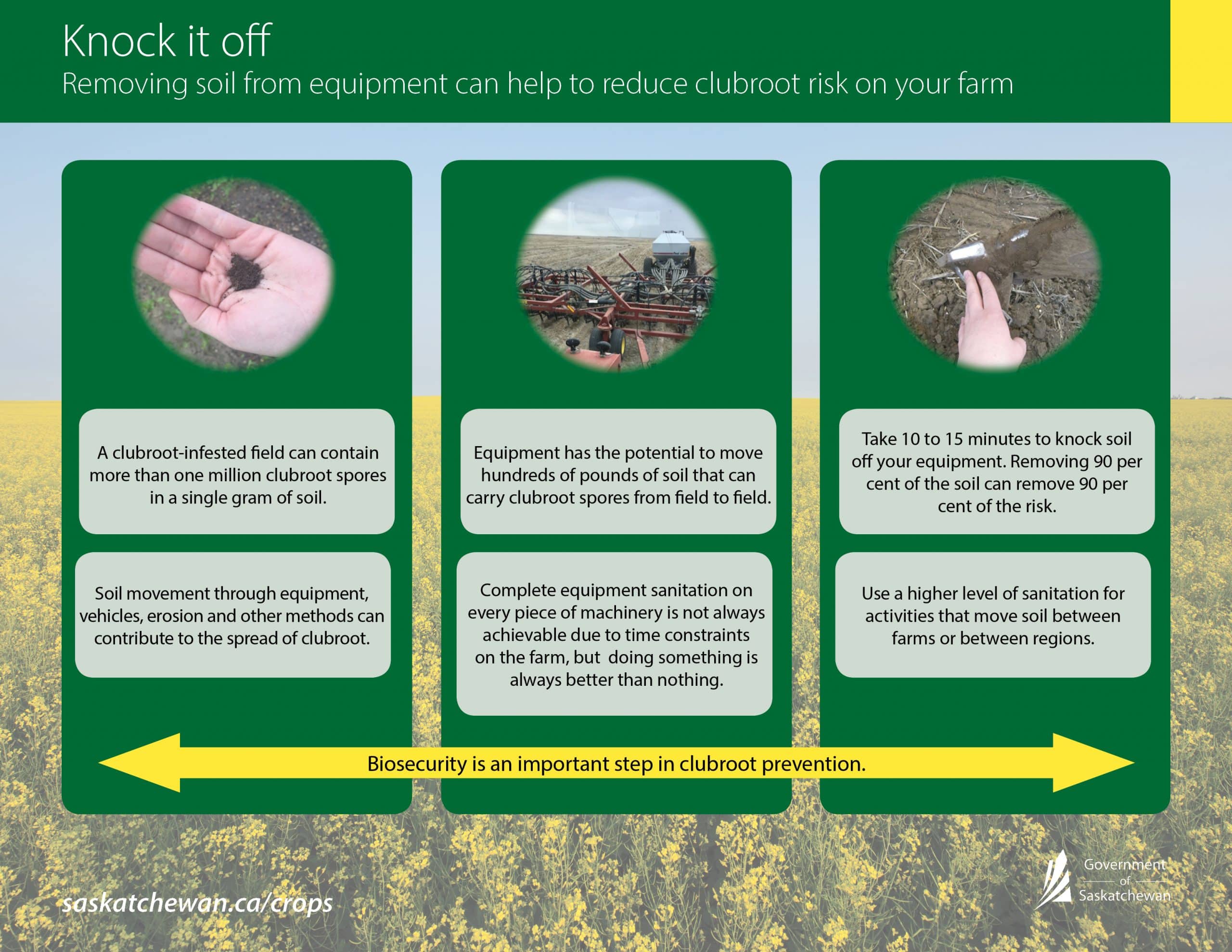If you read nothing else about clubroot, read this article. It covers the basic management practices for all canola growers. The whole point of these core practices is to keep clubroot spores low and local.
Limit soil movement. Minimize the risk of soil movement onto your farm by ensuring that incoming traffic is free of soil and that your operations minimize the movement of soil from field to field. The most effective time spent reducing clubroot risk is usually the first few minutes knocking off the largest dirt lumps. Grassing in field entrances and exits is one way to manage soil movement into and out of fields. READ MORE
Grow CR varieties. Clubroot resistant (CR) varieties should be deployed before the disease becomes established in your area. Clubroot is difficult to find immediately after it arrives and there can be multiple cycles of canola grown on infested land before the disease is detected. Each time a susceptible host is grown in the presence of the disease, clubroot spores multiply and become more difficult to manage. It is crucial to continue diligently scouting CR varieties to detect shifts in the pathogen population that favour any pathotypes not controlled by the resistant genes deployed. Using CR varieties early in extended rotations when clubroot risk exists will help keep pathogen levels low and minimize potential yield losses to the disease. READ MORE
Scout often…even if growing CR varieties. This repeats a point in the previous paragraph, but it deserves its own heading. You want to find clubroot when spores are low and local – before the disease starts to show above-ground symptoms. Scouting should include digging for galls in high-risk areas and possibly soil testing to detect the clubroot pathogen at low levels using DNA-based testing. Be diligent in scouting for clubroot at field entrances, low spots, water runs, weedy areas, lease roads and any areas with a history of higher soil disturbance or traffic. Continued scouting is important when growing CR varieties because they may not be resistant to all pathotypes within a field. Clubroot exists as a pathotype population in fields, and there would rarely be only one strain, or pathotype, present. To date, there are many pathotypes which have been identified and more continue to be identified each year across the Prairies. No current CR varieties are resistant to all pathotypes. They may not have resistance to unique pathotypes lurking in the background at low levels in the population. Levels of these unique or resistance-breaking strains can increase when CR varieties are grown in short rotation (which is not recommended).
Provide a minimum two-year break between host crops. Crop rotation is a valuable tool to prevent clubroot spores from multiplying quickly. It will also help to ensure that CR varieties remain effective for as long as possible. Effective rotation requires a move away from all host crops (including canola and mustard) for a minimum two-year break (three-year rotation) with good control of volunteer canola and host weeds in break crops. Allowing a break from canola and host weeds will increase the rate at which the spore load declines, making clubroot more manageable. Note that a long rotation will not prevent clubroot spores from arriving on your farm, nor will it be enough on its own to manage clubroot.
Control host weeds/volunteer canola in all crops. Known clubroot hosts include canola volunteers, brassica weeds (flixweed, stinkweed, shepherd’s purse, wild mustard), tame mustard, camelina and most other brassica crops and brassica vegetables.
Use ‘patch management’ techniques. Various techniques can reduce spore levels and minimize soil movement from affected areas. A patch with visible symptoms in an otherwise normal field could be a million times more infested than the remainder of the field. Even zero-till seeding still drags soil once a year out of these small areas. Heavy harrowing can pull poorly rooted plants from this patch and scatter them elsewhere. Letting these spores die in place within the small area of these infested patches is a management tactic worth trying. Read ‘How to contain a clubroot-infested patch‘.
Now that you’ve read the article, watch this awesome graphic video of how clubroot works.


